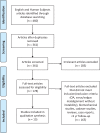Clinical Outcomes of High Tibial Osteotomy for Knee Instability: A Systematic Review
- PMID: 27047982
- PMCID: PMC4790424
- DOI: 10.1177/2325967116633419
Clinical Outcomes of High Tibial Osteotomy for Knee Instability: A Systematic Review
Abstract
Background: In recent years there has been an increasing interest in high tibial osteotomy (HTO) to treat patients with chronic knee instability due to posterolateral corner (PLC), posterior cruciate ligament (PCL), and anterior cruciate ligament (ACL) insufficiencies with concurrent malalignment in the coronal and/or sagittal plane.
Purpose: To perform a systematic review of the use of HTO for the treatment of knee ligament instability with concurrent malalignment.
Study design: Systematic review; Level of evidence, 4.
Methods: A systematic review of the literature was conducted for the treatment of combined knee ligament instability and malalignment with HTO using the Cochrane Central Register of Controlled Trials, PubMed, and MEDLINE (1980 to present); the queries were performed in July 2015. Terms searched included the following: high or proximal tibial osteotomy, unstable, instability, laxity, subluxation, tibial slope, and malalignment, in the knee joint. Inclusion criteria were as follows: HTO to treat instability of the knee joint in the sagittal and/or coronal plane, minimum 2-year follow-up with reported outcomes measures, English language, and human studies. Animal, basic science, and cadaveric studies were excluded as well as editorials, reviews, expert opinions, surveys, special topics, letters to the editor, and correspondence.
Results: The search resulted in 460 studies. After applying exclusion criteria and removing duplicates, 13 studies were considered. Of the studies reviewed, knee ligament pathologies, previous surgeries, and measurement of knee stability were heterogeneous. However, all studies reported an improvement in knee stability after HTO. Most studies reported improvement in outcome scores. However, other studies did not provide preoperative scores for comparison. Reported complication rates ranged from 0% to 47%.
Conclusion: Although HTO has been highly advocated and used in treating patients with ligamentous knee instability, there remains a paucity of high-quality studies. Included studies report improvement of instability as well as relatively high patient satisfaction and rate of return to sports. The heterogeneity of the pathology treated, follow-up time, and outcome measures limit comparison between studies.
Keywords: high tibial osteotomy; instability; laxity; malalignment; proximal tibial osteotomy; tibial slope.
Conflict of interest statement
One or more of the authors has declared the following potential conflict of interest or source of funding: R.F.L. receives royalties from Arthrex and Smith & Nephew; is a paid consultant for Arthex, Ossur, and Smith & Nephew; receives research support from Arthrex, Linvatec, Ossur, and Smith & Nephew; and has patents pending with Ossur and Smith & Nephew.
Figures
Similar articles
-
Clinical outcomes and long-term efficacy of high tibial osteotomy in treating knee instability: An updated systematic review.SICOT J. 2025;11:6. doi: 10.1051/sicotj/2024061. Epub 2025 Jan 23. SICOT J. 2025. PMID: 39846478 Free PMC article.
-
The Impact of Osseous Malalignment and Realignment Procedures in Knee Ligament Surgery: A Systematic Review of the Clinical Evidence.Orthop J Sports Med. 2017 Mar 27;5(3):2325967117697287. doi: 10.1177/2325967117697287. eCollection 2017 Mar. Orthop J Sports Med. 2017. PMID: 28451605 Free PMC article. Review.
-
Role of high tibial osteotomy in chronic injuries of posterior cruciate ligament and posterolateral corner.J Orthop Traumatol. 2011 Mar;12(1):1-17. doi: 10.1007/s10195-010-0120-0. Epub 2010 Nov 24. J Orthop Traumatol. 2011. PMID: 21107635 Free PMC article. Review.
-
The effect of proximal tibial slope on dynamic stability testing of the posterior cruciate ligament- and posterolateral corner-deficient knee.Am J Sports Med. 2012 Jun;40(6):1322-8. doi: 10.1177/0363546512439180. Epub 2012 Mar 16. Am J Sports Med. 2012. PMID: 22427622
-
The role of high tibial osteotomy in the treatment of knee laxity: a comprehensive review.Knee Surg Sports Traumatol Arthrosc. 2015 Oct;23(10):3026-37. doi: 10.1007/s00167-015-3752-z. Epub 2015 Aug 21. Knee Surg Sports Traumatol Arthrosc. 2015. PMID: 26294054 Review.
Cited by
-
Clinical outcomes and long-term efficacy of high tibial osteotomy in treating knee instability: An updated systematic review.SICOT J. 2025;11:6. doi: 10.1051/sicotj/2024061. Epub 2025 Jan 23. SICOT J. 2025. PMID: 39846478 Free PMC article.
-
Combined Arthroscopic Anterior Cruciate Ligament Reconstruction and Distal Femoral Osteotomy in a Patient of Bilateral Genu Valgum - A Rare Case Report.J Orthop Case Rep. 2025 Feb;15(2):42-48. doi: 10.13107/jocr.2025.v15.i02.5222. J Orthop Case Rep. 2025. PMID: 39957964 Free PMC article.
-
A Systematic Review of all Published Systematic Reviews (SRs) on Multiligament Knee Injuries (MLKIs).Indian J Orthop. 2024 Dec 31;59(4):472-487. doi: 10.1007/s43465-024-01321-1. eCollection 2025 Apr. Indian J Orthop. 2024. PMID: 40276798 Review.
-
The application of proximal tibial anterior closing wedge osteotomy in anterior cruciate ligament reconstruction.Asia Pac J Sports Med Arthrosc Rehabil Technol. 2024 Jul 17;38:1-8. doi: 10.1016/j.asmart.2024.06.001. eCollection 2024 Oct. Asia Pac J Sports Med Arthrosc Rehabil Technol. 2024. PMID: 39113923 Free PMC article.
-
Surgical Techniques, Outcomes, Indications, and Complications of Simultaneous High Tibial Osteotomy and Anterior Cruciate Ligament Revision Surgery: A Systematic Review.HSS J. 2019 Jul;15(2):176-184. doi: 10.1007/s11420-018-9630-8. Epub 2018 Sep 24. HSS J. 2019. PMID: 31327950 Free PMC article. Review.
References
-
- Arthur A, LaPrade RF, Agel J. Proximal tibial opening wedge osteotomy as the initial treatment for chronic posterolateral corner deficiency in the varus knee: a prospective clinical study. Am J Sports Med. 2007;35:1844–1850. - PubMed
-
- Badhe NP, Forster IW. High tibial osteotomy in knee instability: the rationale of treatment and early results. Knee Surg Sports Traumatol Arthrosc. 2002;10:38–43. - PubMed
-
- Bonin N, Ait Si Selmi T, Donell ST, Dejour H, Neyret P. Anterior cruciate reconstruction combined with valgus upper tibial osteotomy: 12 years follow-up. Knee. 2004;11:431–437. - PubMed
-
- Boss A, Stutz G, Oursin C, Gachter A. Anterior cruciate ligament reconstruction combined with valgus tibial osteotomy (combined procedure). Knee Surg Sports Traumatol Arthrosc. 1995;3:187–191. - PubMed
LinkOut - more resources
Full Text Sources
Other Literature Sources


